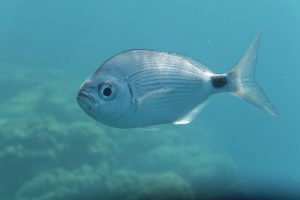The Myrtle Beach area is a popular destination for both local and international tourists because of the expansive white beaches, excellent seafood restaurants, and various golf links.
The beach area boasts a steep profile with depths of 6ft to 1125 ft. This makes it attractive to lots of marine life and sharks in particular.
Approximately nine shark species have been spotted in Myrtle Beach, including spinner sharks, black tips, bull sharks, tiger sharks, lemon sharks, great whites, sandbars, sand tiger sharks, and hammerhead sharks.
Below are common characteristics and behaviors that you can use for identification whenever you come across a fish you suspect to be a shark in the Myrtle Beach area.
Table of Contents
1. Spinner Sharks (Carcharhinus brevipinna)
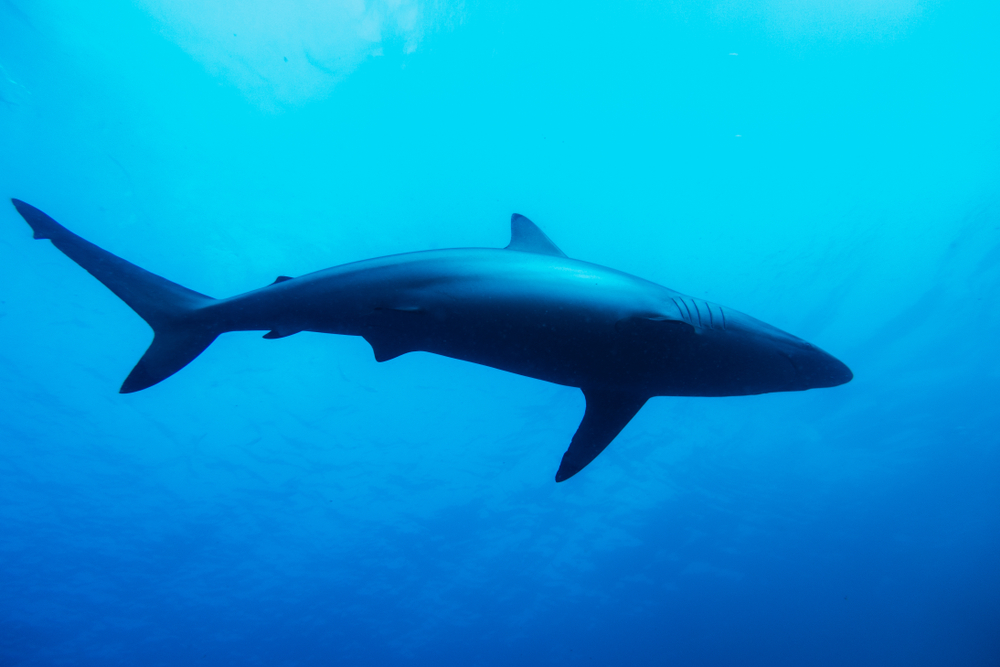
Spinner sharks are small sharks with a spear-like snout with two rows of sharp teeth. They are found in the shallow waters of the Atlantic and Pacific oceans and feed mainly on small fish and invertebrates.
Size
Length: 2–3 feet (0.6-0.9 meter). Weight: 30 pounds (13 kilograms).
Behavior
They are occasionally seen by divers, swimmers (in the shallows), and surfers. While most of these sharks are not aggressive, they may become aggressive if approached too closely.
Be especially careful in waters with a school of spinner sharks swimming nearby.
Appearance
The head shape is highly variable, but all spinner sharks have a long snout with two rows of sharp teeth.
The eyes are large and round. Coloration ranges from translucent to dark brown and black.
Feeding Habits
Spinner sharks are called so because they have a habit of spinning or rolling while feeding. Their diet consists of fish and invertebrates.
Habitat
Spinner sharks are found in tropical and temperate waters from the intertidal zone to a depth of 430 feet (130 m).
They frequent sandy bays and seagrass beds in shallow coastal waters. They swim close to shore, often in schools at depths of less than 6 feet (2 meters).
2. Blacktip Shark (Carcharhinus limbatus)
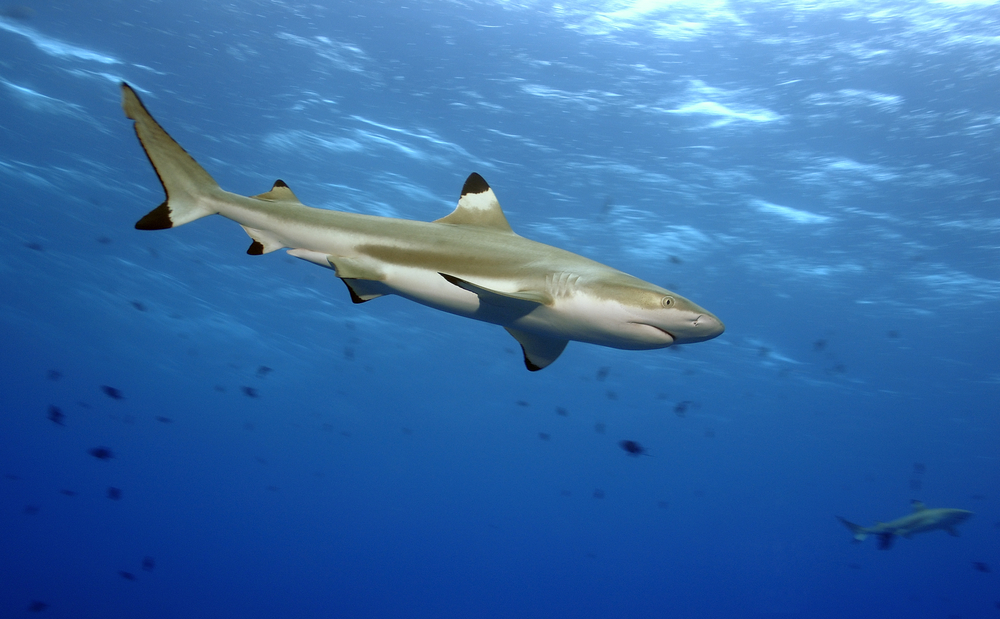
The blacktip shark (Carcharhinus limbatus) is a slender, black, dusky-grey, or grey-brown shark with a long, dark band of small dark spots on the tail.
The mouth is small, and the back has three dark saddles. It is found in both temperate and tropical waters worldwide.
Size
Length: 3–4 feet (0.9-1.2 meter). Weight: 100 pounds (45 kg).
Behavior
They are fast swimmers and can leap out of the water to pursue prey.
They can be found anywhere from oceanic to nearshore waters. They often swim near reefs but sometimes venture far out into the open sea.
They are active nighttime feeders, preying on fish and crustaceans when hunting for food.
Appearance
It has a long, pointed snout with narrow eyes and a wide mouth filled with tiny sharp teeth.
The tail is slender, with a dark spot on top and a spine on the bottom.
Many blacktip sharks are covered in tiny spots, though some are clear of spots. This species reaches maturity at three years of age and has an average lifespan of 15 years.

These sharks have high fecundity, and therefore high numbers are found most commonly near garbage dumps or sewage outfalls, where they follow the currents to feed off of food that humans have thrown away.
Diet
Blacktip sharks are carnivores. They feed on small crabs, shrimp, worms, and occasionally sea birds and even other sharks.
When chasing prey or fighting, the blacktip shark can spray water out of its mouth very fast.
The blacktip shark can leap out of the water and spray water from its mouth at speeds up to 9 meters per second or 18 miles per hour.
Habitat
Blacktip sharks are found in temperate and tropical waters worldwide. This is the most common shark in the western Atlantic Ocean, with one exception.
The “black tip” is not located in Bermuda due to the lack of feeding opportunities.
3. Bull Shark (Carcharhinus leucas)

The bull shark (Carcharhinus leucas) is a species of requiem shark from the family Carcharhinidae. Inhabiting shallow waters in warm oceans, it has the widest distribution of all sharks, including tropical areas outside the natural range of oceanic whitetips (Carcharhinus longimanus).
The bull shark can survive in salty and fresh waters, and they have been spotted many miles upstream in several instances.
Size
Length: 8–11 feet (2.5-3.4 meters). Weight: 230 pounds (105 kilograms). Adults can weigh between 350 to 1,000 pounds (160 to 450 kilograms).
This species grows faster than any other shark and can reach lengths of 14 feet (4 meters) and weighs over 1,000 pounds (450 kilograms).
They are also the largest shark ever known to have been kept in captivity.
Behavior
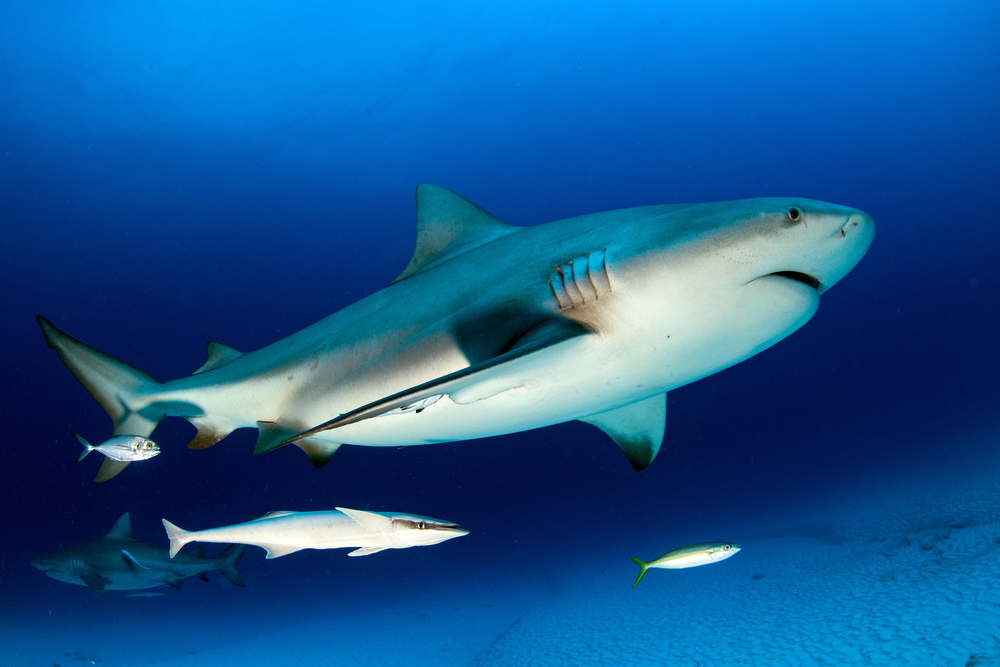
Generally quiet during daylight hours, this species is most active at night. It makes frequent excursions into shallow bays and harbors.
It is found in warm waters worldwide, preferring temperatures of 72–82˚F (22–28˚C). Bull sharks are slow-moving sharks that feed mainly on bony fish, rays, crustaceans, eels, birds, turtles, and mammals.
If caught in nets, they are often seen thrashing around until exhaustion. Bull sharks have been known to attack humans.
Bull sharks attack humans when provoked or injured – or when the shark mistakes them for food.
Appearance
The bull shark is a stocky, powerful shark with a broad, flat snout that resembles a shovel. The bull shark’s upper teeth are exposed when the mouth is closed; the upper and lower teeth are triangular with serrated edges.
The coloration is brown to bluish-gray on top and white underneath.
Young sharks have four to five dark, vertical stripes which fade as the shark matures. Females tend to be larger than males; no difference in size is seen between mature males and females at about ten feet (3 m).
Habitat
The bull shark is found worldwide in warm, shallow waters along coasts and rivers.
4. Tiger Shark (Galeocerdo cuvier)
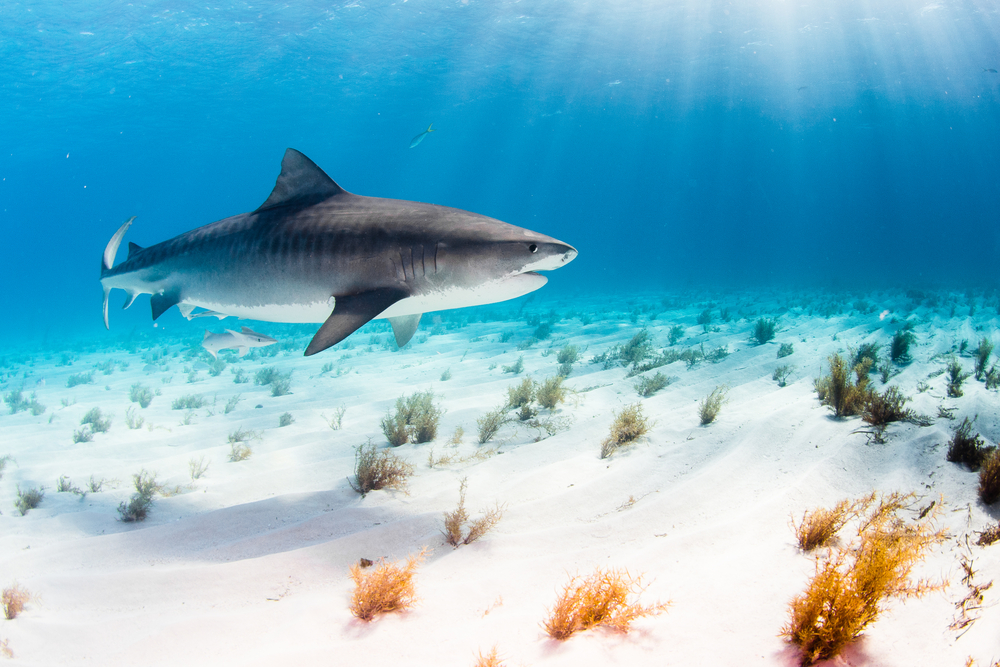
The tiger shark is a requiem shark in the family Carcharhinidae. It is the only member of the genus Galeocerdo and the only extant member of the subfamily Carcharhininae.
As a requiem shark and orectolobiform, it has features common to both Old World (i.e., sharks that lived during the Eocene and Oligocene epochs) and New World (sharks that live in the Americas) genera but is found only in the Americas.
It is found in tropical, subtropical, and warm temperate waters worldwide, with some populations inhabiting sheltered coastal habitats.
The tiger shark has a wide distribution in the Atlantic Ocean.
Size
Length: 12–18 ft (4-5 m) Weight: 420–760 lbs. (190 – 320 kg)
Habitat
Tiger sharks love tropical reefs, inshore coastlines, and estuaries.
Appearance
Moderately stout body with a broad, rounded snout; dark areas around the eyes and mouth, lighter upper surfaces and white underneath; young have five dark vertical stripes.
Diet
Small to large bony fish, rays, other sharks, and invertebrates, including octopus and squid.
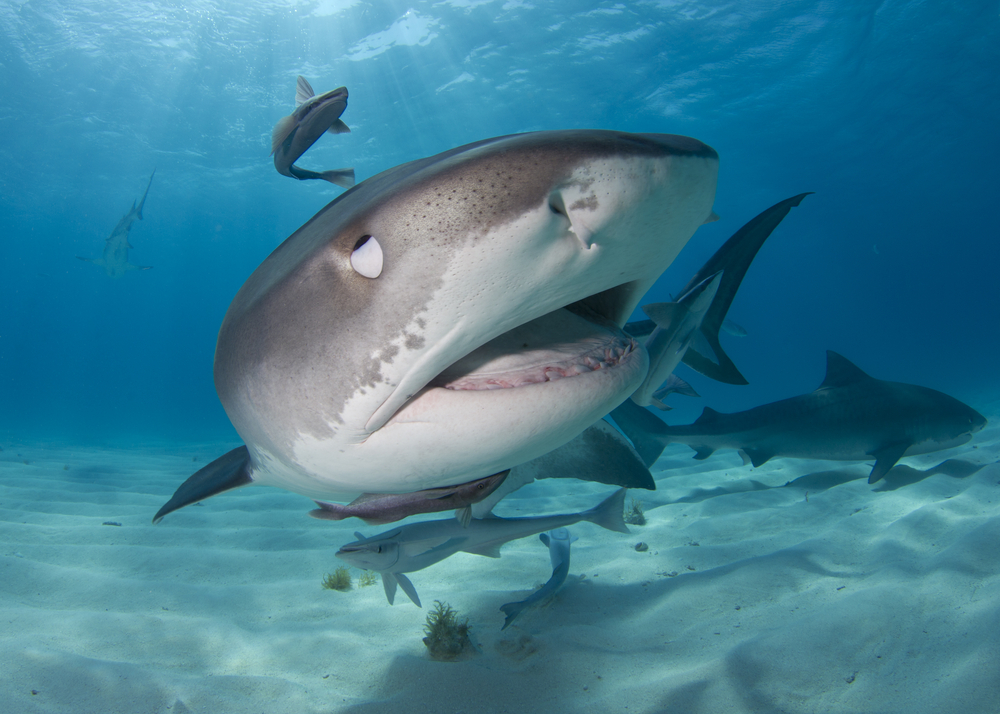
This shark attacks humans at times of stress or for curiosity or territorial reasons (the tiger shark is the only shark known to attack humans without provocation).
Its powerful jaws are used for crushing prey and aid in digestion.
Reproduction
After a gestation period of 10 to 11 months, 1–14 young ones are born in spring or summer.
Newborns measure only 8 inches or 20 centimeters.
The mother carries her young in a shallow, web-like esophagus connecting her belly to her mouth and may swim 200 yards (meters) while they are inside.
As they mature, the young tiger sharks grow slowly; full-grown adults can be up to 12 feet (4 meters) long and weigh up to 660 pounds (300 kilograms).
They live anywhere from 4 to 5 years.
Behavior
Tiger sharks prefer sandy, muddy, or rocky shores and can be found on the bottom or swimming just above the bottom.
These sharks have been observed leaping out of the water when attacking prey near the surface. It can move quickly in short bursts but usually swims lazily near the seafloor.
5. Lemon Sharks (Negaprion brevirostris)
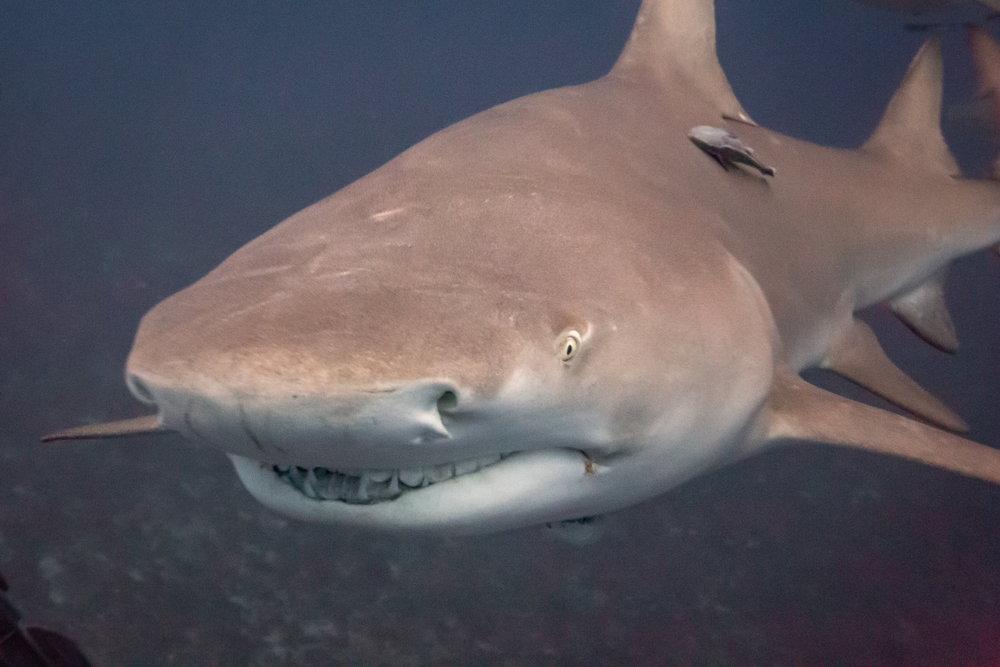
The lemon shark is a species of requiem shark and the most typical member of its family. It is found worldwide in warm, open waters between 50 and 60 degrees latitude.
The name “lemon shark” comes from the yellow color on its underside, which results from a layer of fat under the skin.
Size
Length: 6–8 ft (2 – 2.5 m) Weight: 280 lbs. (127 kg)
Habitat
Shallow coastal waters, bays, and estuaries in tropical, subtropical, and warm temperate waters throughout, though they usually remain south of 40°N or north of 40°S.
Lemon sharks are common near the water’s surface.
Appearance
The lemon shark is small, growing to approximately 6 feet (2 meters) in length. It has a broad, flattened head and wide-set eyes.
The lemon shark’s body is completely covered with non-overlapping scales, each with its own slit-like hole for viewing and excretion purposes.
Its gill openings are large and positioned somewhat behind the angle of the pectoral fins. The upper lobe of the caudal fin is shorter than the lower lobe and has an indistinct lower lobe.

This species is plain gray, its underside shading to white-ish yellow on the belly.
Behavior
The lemon shark is a very active species, often attaining high speeds in short bursts of activity.
It is generally diurnally active and spends most of the day in areas of moderately high productivity, such as seagrass beds and rocky reefs.
The lemon shark is a coastal species that is found in shallow waters. It prefers water temperatures near the upper end of its range.
Diet
This species is an opportunistic feeder. It preys upon various organisms, including crustaceans, cephalopods, bony fishes, and other sharks.
The lemon shark’s diet overlaps with many other species of sharks and fish which occupy similar habitats, making it more vulnerable to predation than most other open-sea sharks.
The lemon shark has been observed preying on other small sharks and bony fishes and squid, octopuses, and eels.
Reproduction
The lemon shark is aplacental viviparous like most other sharks. Females use tendons in their pelvic fins to hold the egg case in place and attach it to the seafloor.
The gestation period lasts around one year, following which females release up to 20 young from July through November.
The size at birth is about 1 foot long (30 cm). The lemon shark reaches sexual maturity at one year of age; males mature later than females, averaging 2–3 years.
6. The Great White Shark (Carcharodon carcharias)

The great white shark is a large lamniform shark living in most coastal and offshore waters, with water temperatures between 12 and 24 °C (54–75 °F).
Its gambling behavior, prominent dorsal fin, and fearsome appearance earn this shark its reputation as a fearsome predator.
It has also been known to attack humans.
Size
The great white shark is a large macropredator, with the largest individuals known to have approached and exceeded 6.1 m (20 ft) in length and 2,268 kg (5,000 lbs.) in weight.
Habitat
It prefers to feed alone in sub-surface waters over continental or insular shelves but is also found at the surface, particularly near islands, and often migrates from deep channels into bays and estuaries.
Appearance
It has the typical requiem shark body type, with a robust pointed snout, eyes placed dorsally on its head, and five-gill slits.
The most distinctive feature of this species is its triangular-shaped caudal fin which is larger than that of other predatory sharks.
Great White Sharks do not have swim bladders but instead rely on an oil-based liver for buoyancy which means they sink when they stop swimming.
Depending on depth and light conditions, this species may be gray, brown, or white in color.
Behavior

Great white sharks are often found near the water’s surface; they swim around in open waters at the surface, looking for prey.
They are generally solitary animals and have been known to have a territorial display where they circle each other.
Great white sharks will hunt alone or in pairs and initiate an attack only when they are confident they can overpower their prey before it defends itself.
They use any available shelter when hunting for prey, such as large bony fish or whales. They are also known to hunt in groups of up to 5 sharks.
Diet
Great white sharks are carnivorous apex predators who feed primarily on seals and marine mammals such as dolphins and sea lions.
Reproduction
Great white sharks are known to mate seasonally between January and March. Females reach sexual maturity at around six years of age.
The gestation period lasts about 12–13 months. The placental connection is lost shortly after the birth of young, which are immediately independent of their mothers.
Great white sharks give live birth, which occurs within hours to a few days after a gestation period of 10 months.
Some smaller species of sharks tend to give birth to twins; however, the great white shark only gives birth to one pup at a time.
7. Sandbar Shark (Carcharhinus plumbeus)
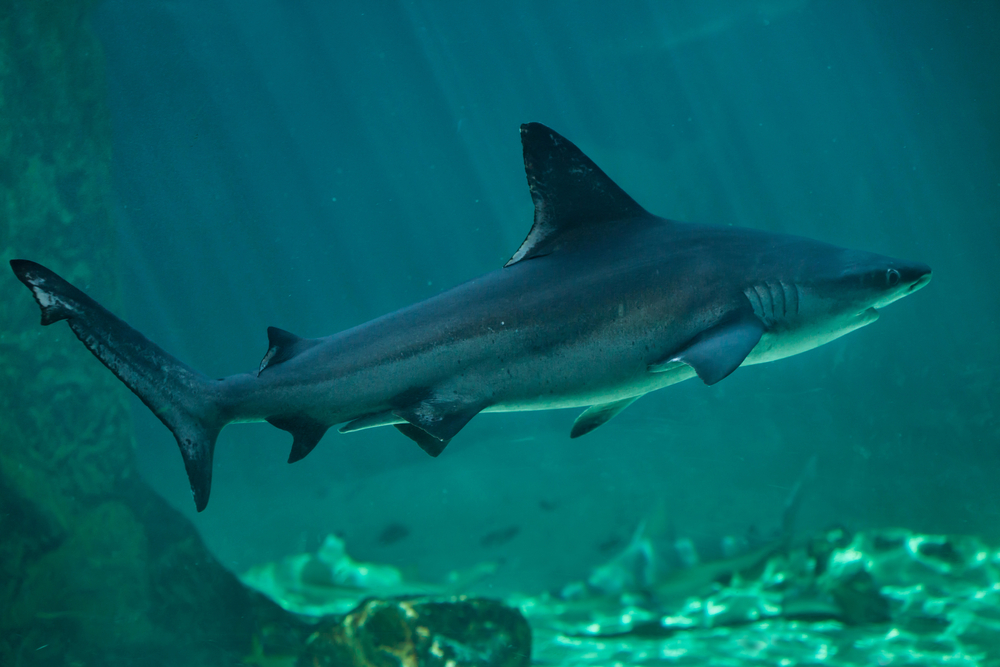
The sandbar shark, sand tiger shark, brown shark, or brown dogfish is a requiem shark found in the coastal waters of the continental shelf and upper continental slope.
This species is a stout-bodied medium-sized shark that is pale blue to grey in color and does not have any identifying marks on its body.
Size
Length: 5 ft 11 in (1.8 m)
Habitat
Found over sandy or muddy bottoms in shallow coastal waters and estuaries with temperatures above 73 °F (23 °C).
Also lives on offshore banks close to shore; adults are usually solitary while juveniles are often found in large groups.
Appearance
Due to its wide gape, sand tiger sharks have a prominent V-shaped notch above the upper jaw.
The snout is short and pointed, with the top of the head being flat and distinct from the jagged lower jaws.
The eyes are small in size and located on top of their braincase.
The mouth is small, with an extremely long upper jaw that protrudes farther than the lower jaw.

Sand tiger sharks have 11–12 tooth rows in their upper and lower jaws, serrated to a triangular point shape, giving off a “V” pattern when viewed from above.
The teeth of the sand tiger shark are large and triangular and do not change with age.
Behavior
Sand tiger sharks are most active during the day and hunt at night. They are quite social animals, mainly found in groups when they are young, but tend to be solitary when they reach five years of age (adulthood).
Diet
Their diet includes octopus, squid, shrimp, squid, mussels, clams, crabs, and lobsters. They are voracious eaters, but they have also been known to eat plastic bags mistaken for jellyfish or squid.
Sand tiger sharks have been known to eat almost anything they can swallow.
Reproduction
The mating season for sand tiger sharks is between April and August, with the gestation period lasting approximately ten months.
The litter size is related to the size of the female, with a single-sex ratio of 1:1 in larger females and a male-biased sex ratio of 0.5:1 in smaller females.
The average litter size is eight pups.
8. Sand Tiger Shark (Carcharias taurus)
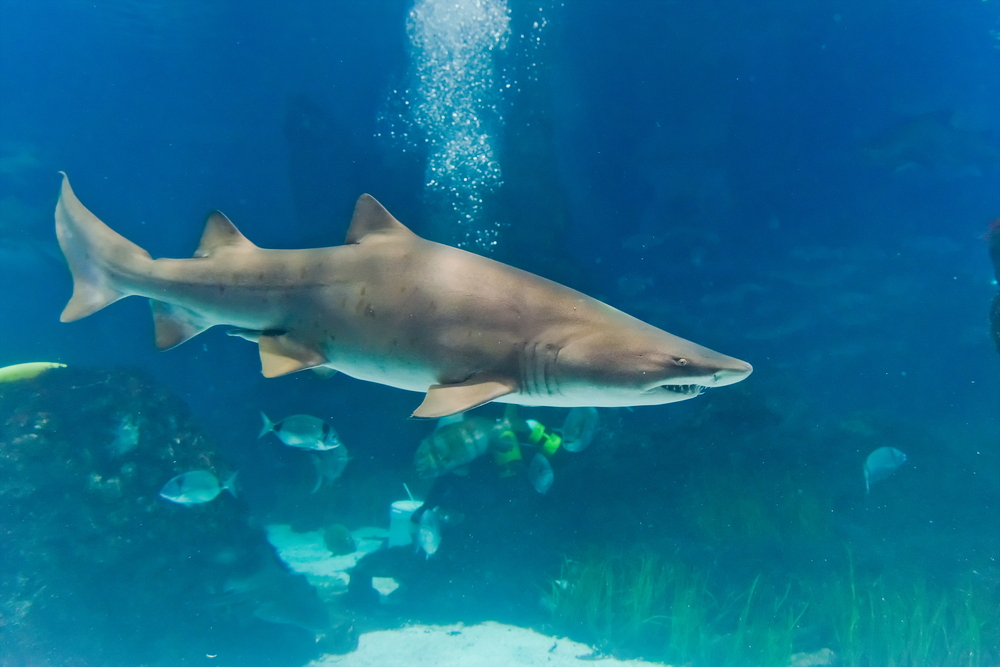
The sand tiger shark (Carcharias taurus) is a species of requiem shark found in the coastal waters of the continental shelf and upper continental slope.
This species is a stout-bodied medium-sized shark with darker grey color and a distinctive dark band running along its length towards its tail fin.
Size
Length: 5 ft 9 in (1.8 m)
Appearance
The sand tiger shark has a very strong body with powerful jaws. The jaws are long and very strong at the front and are lined with rows of teeth.
They have around 12 or 13 teeth in each row, giving them 42–70 total teeth. They use a pectoral fin to steer left or right when swimming forward but do not use it when turning.
Behavior
Sand tiger sharks are very social animals that do not usually travel far from one another. They are found in groups of up to 5,000 individuals during the breeding season.
They use a home range of about 6–7 miles (10 km), across which they patrol for food, resting, and hiding places.
Diet
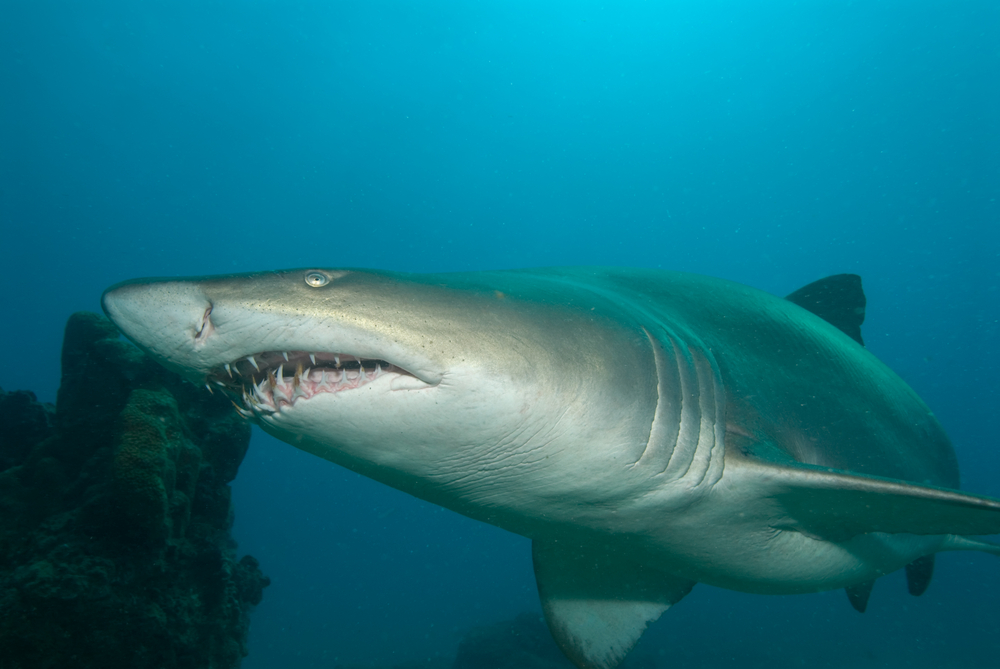
Sand tiger sharks feed on a variety of prey, including invertebrates such as crabs, shrimps, octopus, and squid and fish such as flatfish and croakers.
When hunting, they will mainly swim close to the bottom but occasionally move up towards the surface to catch prey that floats nearby.
Habitat
Found over sandy or muddy bottoms in shallow coastal waters and estuaries with temperatures above 73 °F (23 °C).
This shark also lives on offshore banks close to shore; adults are usually solitary while juveniles are often found in large groups.
Sand tiger sharks live in shallow coastal waters where they can swim using their single dorsal fin and tail fin to control their direction of travel.
Reproduction
The mating season for sand tiger sharks is between April and August, with the gestation period lasting approximately ten months.
9. Hammerhead Sharks (Sphyrna gilberti)
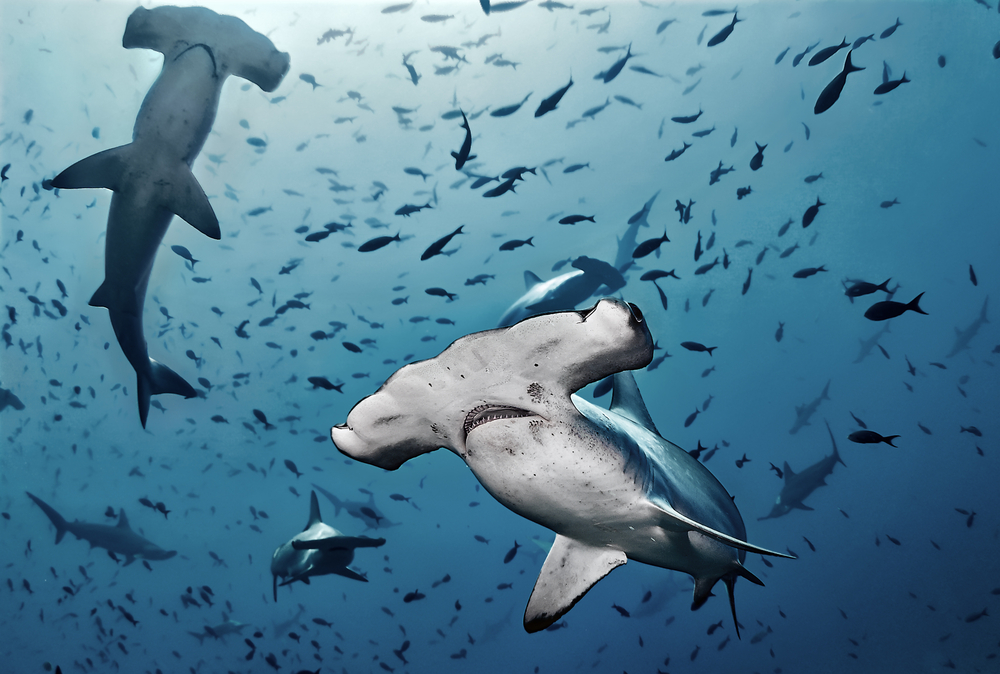
The hammerhead shark is a species of hammerhead shark that can be found in the warmer waters of the tropical Indo-Pacific area.
This species is completely grey in color, with each one having its own distinctive markings.
Size
Length: 4 ft 11 in (1.5 m)
Habitat
Found around coastal waters and estuaries over sandy or muddy bottoms and at depths up to 330 ft (100 m).
They are also found in freshwater rivers and lakes, with some individuals known to travel as far north as New York City.
Appearance
The head of the hammerhead shark is much wider than other sharks, giving it its name. One of its most distinctive features is the pair of lateral extensions on the cephalofoil (the upper lobe of the tail fin) that resemble “hammer-like” appendages.
It also has two dorsal fins with spineless “wing-like” pectoral and pelvic fins that are used to propel itself through the water.
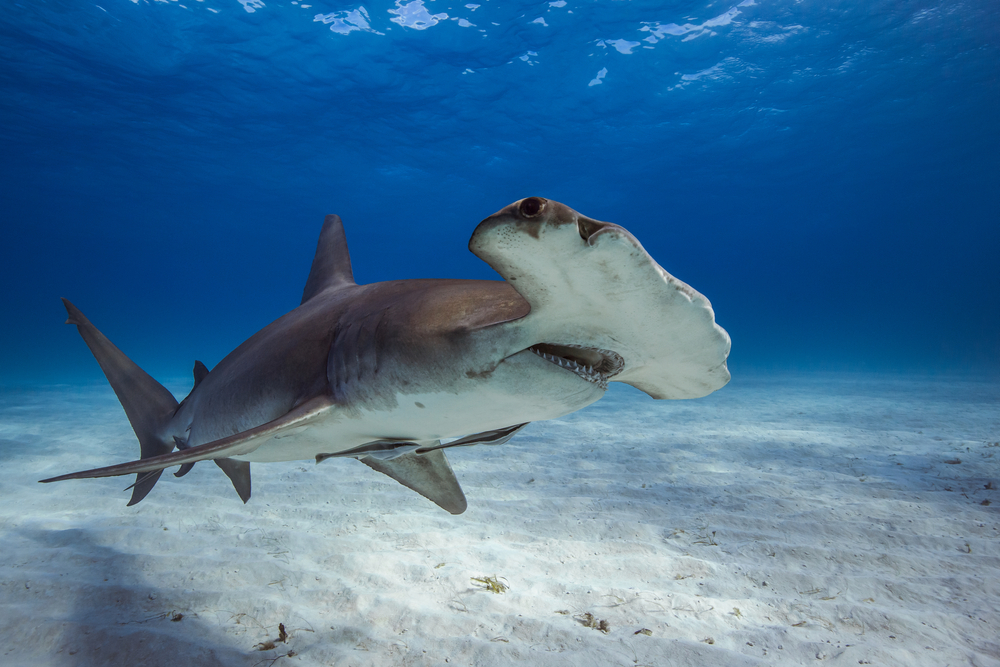
The teeth of a hammerhead shark are very distinct as they have a sharp, semi-circular edge used for crushing mollusks and crustaceans.
The mouth of the hammerhead shark contains around 300 teeth set in several rows; all pointed inwards towards the center so as not to damage each other.
A hammerhead shark has a long and slender body, with an enormous head covered by small eyes.
It has a powerful bite force measured at over 10,000 pounds per square inch (1.6 MPa). The mouth of the hammerhead shark is almost completely devoid of teeth, but it does have around 20 rows of small triangular teeth along the upper jaw to aid in catching prey.
These sharks use their body shape to hunt for food like dolphins and porpoises: matching their body movements through the water with those of the prey, making them easier to catch.
They will regularly move to avoid predators and ambush prey by rapidly changing direction when they approach.
They eat fish, rays, squid, and larger invertebrates.
Behavior
Hammerhead sharks are very social animals that rarely travel far from one another. They are found in groups of up to 12 individuals during the breeding season, with small groups at other times of the year.
They use a home range of around 1 mile (1 km), across which they patrol for food, resting, and hiding places.
Hammerhead sharks have been known to be more aggressive than most shark species, with some encounters resulting in injuries for divers.
Diet
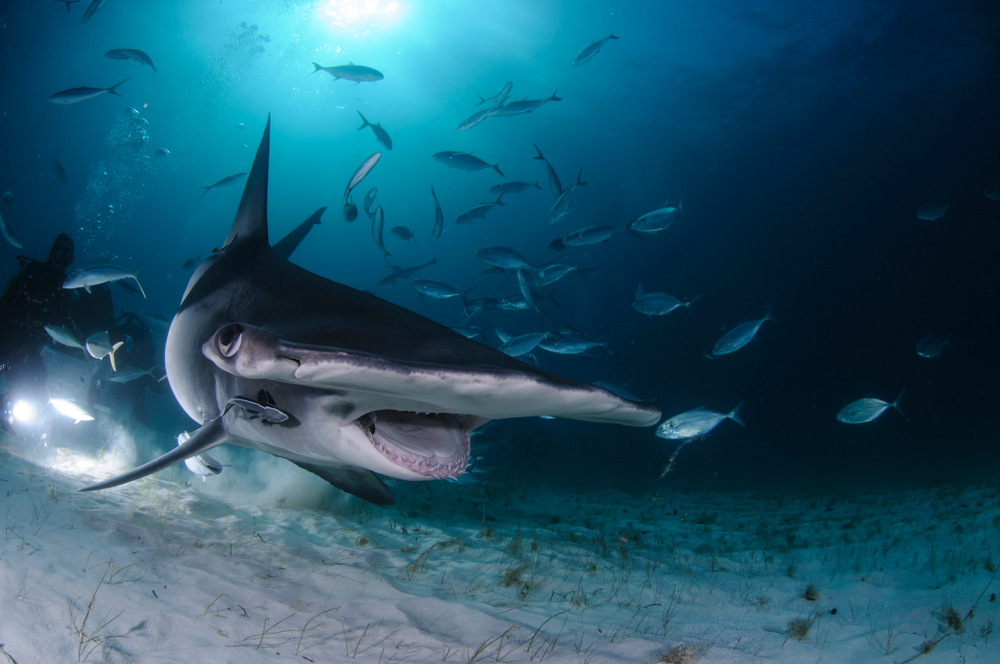
Hammerhead sharks feed on a variety of prey, including fish, squid, and crabs. They are particularly partial to crustaceans and stalk their prey before attacking.
The teeth of the hammerhead shark are powerful, and they use them in much the same way as humans use a can opener, by pressing them into the shell of their prey in a circular motion until they fracture.
Reproduction
The mating season for hammerhead sharks is between April and August. Breeding occurs once a year, so the same pair of sharks mate each time.
Females will give birth to a litter of around 12 pups after nine months, during which they carry them in their mouths or under their tails and, in some cases, even store them in an external pouch on their belly called the marsupium.















